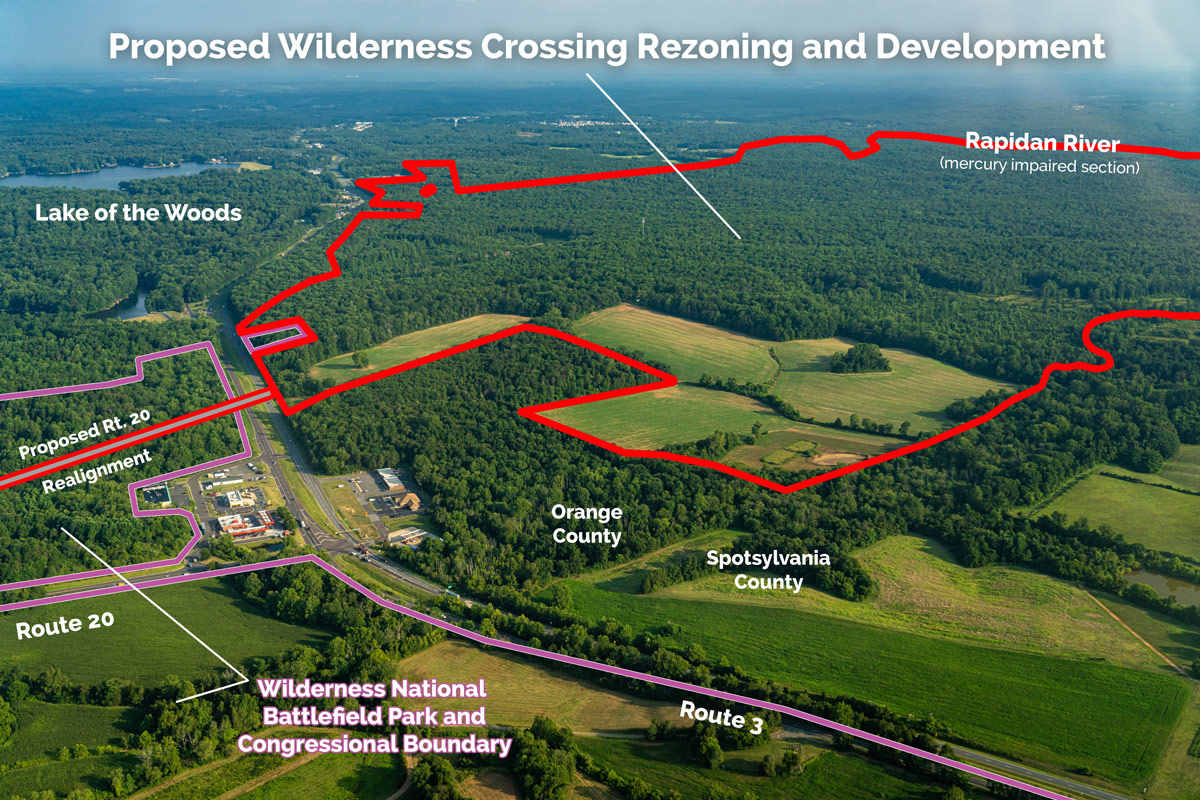
The Orange County Planning Commission held three work sessions (January 5 and 19, February 9) on Wilderness Crossing. A fourth is scheduled for Thursday, February 16. Applicants requesting a rezoning of properties in the Germanna Wilderness Area Plan (GWAP) are required to meet with the Planning Commission in a work session(s) prior to a public hearing. For this proposal, we expect a public hearing to be scheduled for March 23 or April 5.
Here are some key takeaways from the Wilderness Crossing work sessions so far:
Mercury contamination
Commissioners found the developer’s earlier proffer language on the mine contamination to be too equivocal and have pushed for a stronger commitment to remediating the site. The current proffer language agrees to “enter” DEQ’s Voluntary Remediation Program (VRP) and represents some movement in the right direction (as recently as September, the developer was stating publicly that it has “no knowledge” of contaminants on site).
PEC and our partners at the Southern Environmental Law Center (SELC) believe this language does not go far enough. We are concerned that unless the VRP is completed and certified by DEQ, the County risks taking on liability, and public and environmental health will remain inadequately protected. This is particularly concerning as the developer has proposed transferring some of the property to the County for parks, a school, and public safety facility. PEC and SELC sent a letter laying out our concerns and some suggested language to the Planning Commission on February 8, but have received no response.
Increased traffic, realignment of Rte. 20
Commissioners have expressed alarm at the prospect of a residential development next to 4.7 million square feet of data centers, distribution centers or other “light industrial” uses with internal roads wide enough to accommodate tractor trailers and other truck/industrial traffic coming and going 24 hours a day. It has also been revealed that the developer has filed for a special exception to increase the height limit in the proposed industrial areas from 45 to 80 feet (approximately seven stories).
We urge Orange County to consider whether residential areas within the project would be compatible with the potential for over 700 acres of seven-story industrial development and the attendant truck traffic.
It’s also not clear that the realignment of Rte. 20, included in the County’s adopted Germanna Wilderness Area Plan, is necessary or that it is the only solution to traffic concerns at the intersection of Rte. 3. VDOT representatives have told the Planning Commission that the developer has long promoted the idea as part of its plan with Wilderness Crossing. This contradicts what the developer told the public at their September town hall – “[the realignment] is VDOT’s plan, not ours…” The developer owns the land in question, surrounded on both sides by protected battlefield. The “new” Rte. 20 would funnel traffic directly to the front entrance of the Wilderness Crossing retail center, benefiting the developer.
Water concerns
When pressed by Planning Commissioners, the Rapidan Service Authority (RSA) acknowledged that in a drought situation, like in 2002 when water restrictions were imposed, the County is solely reliant on the Rapidan River and would need to enact restrictions just to supply current residents. With the developer hoping to attract thousands more future residents, there is no telling what water availability would look like. Furthermore, the two reservoirs the developer has offered to set aside land for on the property would only hold about a 52-day supply. It was also revealed that RSA has not even reviewed the latest revisions to the Wilderness Crossing land use master plan (fewer homes, but now 732 acres of industrial use, up from 150 acres).
Sprawling, cookie-cutter, car-centric design elements and development pattern
Commissioners have not been pleased with the developer’s intent to make the town center fully visible from Rte. 3 and have pressed for at least a 100-foot buffer. The developer acknowledged that for a retail center like the one being proposed at Wilderness Crossing to be viable, it has to be located along and visible from a busy road. In this case, to pull in customers traveling along Rte. 3. Despite being touted as a “town center,” a term that implies centrality to community life in the residential development, the retail/commercial district would stretch along Rte. 3 and prioritize passersby. In other words, many residents of Wilderness Crossing would not be within walking distance of the retail, grocery stores, restaurants, or services that are used as a selling point.
Commissioners have also been dissatisfied with the current design guidelines. They pushed back that this should not even be described as a town center – considering the fake second stories, for example – and were adamant that it would look just like a dressed-up strip mall that you would find around I-95 in Fredericksburg. In addition, the view from Lake of the Woods and Rte. 3 would be the backside of these buildings.
What’s next?
The Planning Commission’s next work session is scheduled for 6:00 p.m. on February 16 at the Orange County Public Safety Building, located at 11282 Government Center Drive. While there will not likely be a time for public comment at this work session, the meeting is open to all. I encourage you to attend and hear directly from the developer, and to show the Planning Commission that residents are paying attention to Wilderness Crossing. The work session will also be available to watch online.
